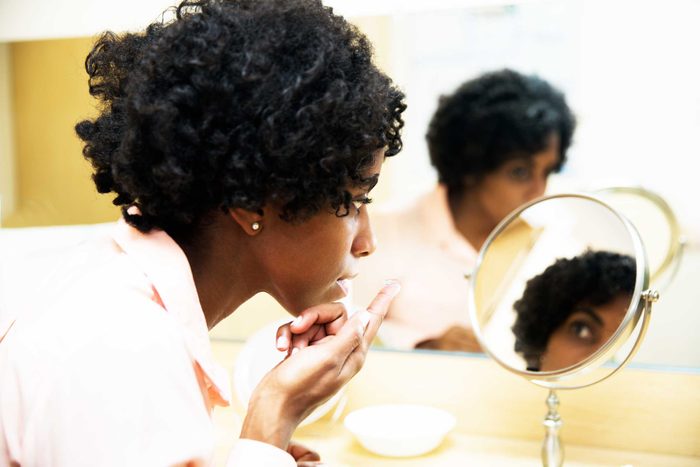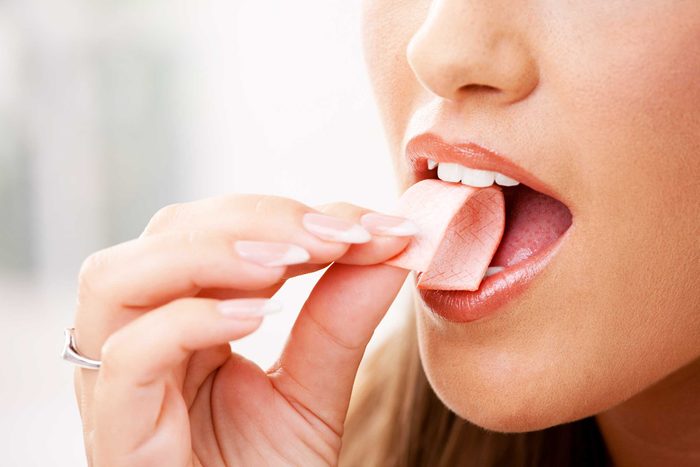
Rubbing your eyes
The skin around your eyes is super delicate and prone to damage. “Rubbing this sensitive area stretches skin and breaks down collagen and elastin, which can result in wrinkles,” says Sejal Shah, MD, a dermatologist in New York City. The more you do it, the worse it gets. Have you ever pulled your lids taut to apply eyeliner? This has the same damaging effect. (Here’s what dermatologists want you to know about getting rid of wrinkles.)

Leaving your shades at home
Squinting at the sun—or even your phone or computer—forces the muscles between your brows and around your eyes to contract, which in turn causes the overlying skin to crease. “Initially you may see the wrinkle only when you make the movement, but over time the collagen will break down and the wrinkles will become deeper and fixed,” says Dr. Shah. The most common symptom of squinting? Crow’s feet! The best way to prevent them is to wear sunglasses. Be sure to see your eye doctor if you notice you’re squinting to see—it could be a sign that you need glasses. Check out the other sneaky signs you could need glasses (or a new prescription).

Wearing contact lenses
The act of wearing contacts alone doesn’t cause wrinkles—or fewer people would buy them! But the way you’re inserting them definitely can. Often when we put in contacts, we raise our brows. (We also tend to do this when applying mascara.) Similar to squinting, this repetitive movement causes the skin on your forehead to wrinkle, Dr. Shah says. (Here’s how bad it is to sleep with your contacts in.)

Eating too much sugar
Dessert tastes delicious, but it’s not so sweet for your skin. According to Dr. Shah, excess sugar intake can result in the formation of “advanced glycation end products” (AGEs), harmful compounds that are formed when protein or fat combine with sugar in the bloodstream. These compounds can damage collagen and elastin, leading to wrinkles and sagging skin. Did you know that certain foods can actually help fight wrinkles?

Lack of sleep
Beauty sleep is a real thing. The hours when you’re conked out are when your skin repairs and renews itself. If you’re depriving yourself of a good night’s rest, your complexion won’t be able to rehab itself efficiently, leading to less cell turnover and a dull complexion. In fact, a study in the journal Sleep found that sleep deprivation affects facial features such as the eyes, mouth and skin, causing hanging eyelids, redder and more swollen eyes, and darker circles under the eyes. Here’s how to sleep your way to smoother skin.

Sleeping on your stomach
“When you sleep on your stomach, your face is smushed down against the pillow, pushing the skin into creases,” says Dr. Shah. “After several hours in this position, the wrinkles became etched into your face.” Stomach sleepers also may notice increased puffiness around the eyes, as this position makes it more difficult for fluid to drain. The solution: Snooze on your back with your head slightly elevated. These are the best sleep positions for your health concerns.

Staring down at your devices
When you’re staring down at your phone, tablet, or other electronic devices for hours every day, you bend your neck repeatedly. This action causes lines and wrinkles to form on your neck—a phenomenon sometimes dubbed tech neck. Just as squinting and frowning can cause lines on your face, the persistent motion of your neck bending downward puts tension on the muscle—which in turn can create a wrinkle that’s always there, whether you’re moving your neck or not, says Dr. Shah. Check out which of these neck wrinkle masks works best.

Sipping through a straw
Some dentists will tell you to drink coffee or tea through a straw to prevent teeth staining, but dermatologists disagree with that recommendation. In order to use a straw, you have to purse your lips. Like any repetitive motion, it takes a toll on your skin. “Doing this frequently causes wrinkles to form around your lips,” says Dr. Shah. We spoke with dermatologists to identify other signs your face is aging faster than you are.

Resting your face in your hands
Heads are heavy, we get it. But repeatedly resting your face in your hands can create wrinkles. “When your hand props your face up, it also pushes the skin into creases, which can become permanent as this behavior is repeated over time,” explains Dr. Shah. The pressure from your hands can also cause collagen and elastin to break down. This advice can help you reduce wrinkles naturally.

Chewing gum
Chewing gum requires muscle overactivity in the cheeks. When done consistently, it causes the collagen to break down and skin to lose elasticity, which (yep, you guessed it) leads to wrinkles on the cheeks and around the mouth, Dr. Shah says. Good news: It’s best to avoid gum-chewing every day, but occasional chewing won’t cause the problem. In fact, gum chewing can be good for you in several ways.

Exposure to air pollution
Air pollution leads to more than 4 million deaths every year, according to the World Health Organization—and it also takes a toll on your complexion. Daily exposure to smog, cigarette smoke, and car exhaust damage the skin’s barrier, leading to oxidative stress and premature skin aging, says Dr. Shah. These detoxifying ingredients in skincare products can help battle this damage.
